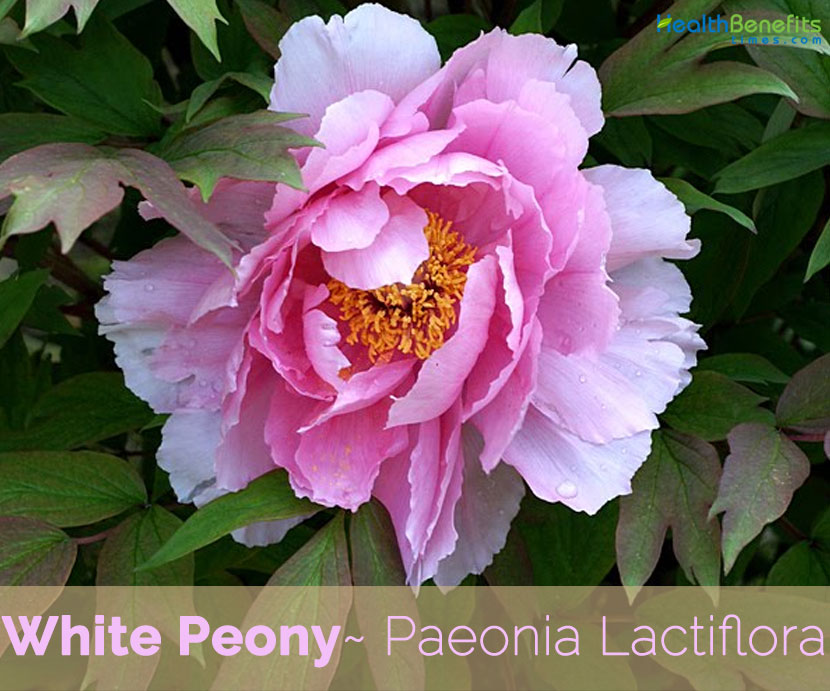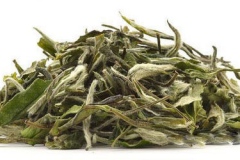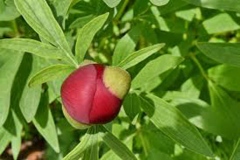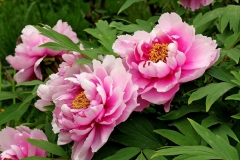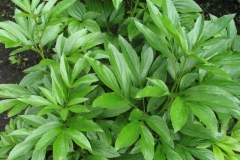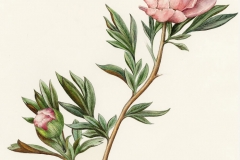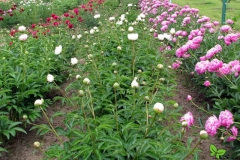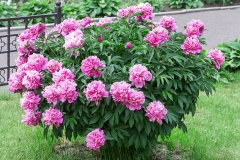Plant Description
White peony is a stout, herbaceous erect, perennial flowering plant that grows about 50–70 cm (20–28 in) tall and broad with thickened (1.3 cm diameter), tuberous root and glabrous branched stems. The plant is thrives best in a deep rich, well-drained and moist soil, preferably neutral or slightly alkaline in full sun or partial shade. It is lime tolerant. Plants grown on sandy soils are reported to produce more foliage and fewer flowers, while those growing on clayey soils take longer to become established but produce better blooms. The plant is classified as a late-blooming species, featuring flowers in mid- to late spring and continuing attractive foliage throughout the summer and early fall. Stems die to the ground after frost. It has been grown in China since the 7th century for appreciation of its ornamental flowers. It was introduced into North America in the 1800 s.
White Peony Facts
| White Peony Quick Facts | |
|---|---|
| Name: | White Peony |
| Scientific Name: | Paeonia lactiflora |
| Origin | Central and eastern Asia from eastern Tibet across northern China, Mongolia, Russia and eastern Siberia |
| Shapes | Follicles oblong–ellipsoid, 2.53 cm long and 1.21 cm wide in horizontal spreading clusters |
| Taste | Pungent, Bitter, Sour, Sweet |
| Health benefits | Blood Tonic, Digestive and Intestinal Problems, Relieves Pain, Calms Mind, Induces Sleep, Strengthens bones, Heart Health, Curbs Cramping, Healthy Brain Function, Healing Powers, Reproductive Rescuer, Combat Stress, Strengthens bones |
| Name | White Peony |
|---|---|
| Scientific Name | Paeonia Lactiflora |
| Native | Central and eastern Asia from eastern Tibet across northern China, Mongolia, Russia and eastern Siberia |
| Common Names | Chinese peony, Common garden peony, White peony, Japanese peony, Garden peony, fragrant peony, tree Peony, Coral Peony, common Peony |
| Name in Other Languages | Afrikaans: Pioen Albanian: Bozhure Arabic: Alfawania (الفاوانيا) Armenian: Kajvard (քաջվարդ) Azerbaijani: Pion Basque: Peonia Belarusian: Pivonia maločnakvietkavaja (Півоня малочнакветкавая), pivonya (півоня) Bengali: Peony Bosnian: Božur Bulgarian: Bonžur (божур) Catalan: Peònia de jardí, peònia Cebuano: Peony Chichewa: Peony Chinese : Bái Shá, Jiu Chao Bai Shao, Moutan, Mu Dan Pi, Sháo, Shao Yao (芍药), mǔdān (牡丹) Croatian: Božur Czech : Pivoňka Bělokorá, pivoňka čínská, pivoňka Danish : Silkepæon, pæon Dutch: Chinese pioen, pioen English: Chinese peony, Common garden peony, White peony, Japanese peony, Garden peony, fragrant peony, Esperanto: Peonio Estonian : Valgeõieline Pojeng, Pojeng Filipino: Peoni Finnish : Jalopioni, Kiinanpioni, pioni French: Pivoine de Chine, pivoine Galician: Peón Georgian: Peoni (პეონი) German : Garten-Pfingstrose, Weisse Pfingstrose, Chinesische Pfingstrose, Pfingstrose Greek: Paionía (παιωνία) Gujarati: Peony Haitian Creole: Pivwan Hausa: Peony Hebrew: אדמונית עשבונית, אַדְמוֹנִית Hindi: Gundali, Peony Hmong: Peony Hungarian: Illatos bazsarózsa, pünkösdi rózsa Icelandic: Peony Igbo: Peony Indonesian: Peony Irish: Peony Italian: Peonia Japanese : Shaku-Yaku (シャクヤク), botan (牡丹) Javanese: Peony Kannada: Peony Kazakh: Pion (пион) Khmer: Peony Korean : Cham-Jag-Yak, Hambagggot, Ho-Jak- Yag, Jag-Yag, Min-Cham-Jag-Yak, jeogjagyag, molan (모란) Latin: Aglaophotis Lao: Peony Latvian: Peonija Lithuanian: Puikusis bijūnas, bijūnas Macedonian: bozhur (божур) Malagasy: Peony Malay: Peony Malayalam: Piyēāni (പിയോനി) Maltese: Peony Maori: Peony Marathi: Peony Mongolian: Tseene (Цээнэ) Myanmar: Peonies Nepali: Peony Netherlands: Pioen, Chineese Norwegian: Kinapeon Persian: گل صدتومانی علفی, گل صد تومانی Polish : Piwonia Chinska, piwonia Portuguese: Peônia Romanian: Bujor Russian: Pion molochnotsvetkovyy (Пион молочноцветковый), pion belotsvetkovyy (пион белоцветковый), pion kitayskiy (пион китайский), pion yaponskiy (пион японский) Serbian: Bozhur (божур) Sesotho: Peony Sinhala: Peony Slovak: Pivonka čínska, pivonka Slovenian : Potonika Somali: Peony Spanish: Peonía Swahili: Peony Swedish : Luktpion, pion Tajik: Peony Tamil: Piyōṉi (பியோனி) Telugu: Peony Thai: Pæa ceī yk (แปะเจียก), Dxk phī xoa ni (ดอกพีโอะนิ) Turkish: Sakayık Ukrainian: Pivoniya (півонія) Urdu: Peony (میں) Uzbek: Piongul Vietnamese : Thuốc Ruoc, Mẫu Ðơn; Bạch Thược, Thược dược Trung Quốc, Hoa mẫu đơn Welsh: Peony Yiddish: Pyani (פּיאַני) Yoruba: Peony Zulu: Peony |
| Plant Growth Habit | Stout, herbaceous erect, perennial flowering plant |
| Soil | Thrives best in a deep rich, well-drained and moist soil, preferably neutral or slightly alkaline in full sun or partial shade. It is lime tolerant. |
| Plant Size | 50–70 cm (20–28 in) tall and broad |
| Root | Thickened tuberous roots |
| Leaf | Alternate, basal leaves biternate; all leaflets decurrent at base, terminal leaflets 2 or 3 segmented, leaflets and segments up to 15, oblong–elliptic, oblique– ovate to lanceolate |
| Flower | Flower buds appear in late spring (May in the Northern Hemisphere). They are large and round, opening into fragrant, cup- or bowl-shaped flowers 8–16 cm (3–6 in) in diameter, with 5–10 white, pink, or crimson petals and yellow stamens |
| Fruit Shape & Size | Follicles oblong–ellipsoid, 2.53 by 1.21 cm in horizontal spreading clusters |
| Taste | Pungent, Bitter, Sour, Sweet |
| Plant Parts Used | Roots, Seeds |
| Health Benefits |
|
| Other Facts |
|
Leaves
Leaves are alternate, basal leaves are biternate. All leaflets are decurrent at base, terminal leaflets are 2 or 3 segmented, leaflets and segments up to 15, oblong–elliptic, oblique– ovate to lanceolate, 4.5–16 cm long and 1.5–4.8 cm wide, pilose beneath, margins rough–scabrous. Leaves may turn rusty orange in fall.
Flower
Flower buds appear in late spring (May in the Northern Hemisphere). They are large and round, opening into fragrant, cup- or bowl-shaped flowers 8–16 cm (3–6 in) in diameter, with 5–10 white, pink, or crimson petals and yellow stamens. Sepals are 3 or 4, broadly ovate or sub orbicular, 1–1.5 cm long and 1–1.7 cm wide. Petals are 9–13, white, red or pink (in wild plants), or varying in color (in cultivated plants), obovate, 3.56 cm long and 1.5–4.5 cm wide. Stamens are numerous, with yellow filaments and anthers. Pink or crimson petals typically feature a visible center boss of yellow stamens. Some double-flowered cultivars are available. Flowers of most cultivars are fragrant.
Fruits
Fertile flowers are followed by horizontally spreading oblong–ellipsoid, follicles that split open at maturity. They are about 2.53 cm long and 1.21.5 cm wide.
Types
There are several hundred selected cultivars in a range of colors, sizes and forms. Many have double flowers, with the stamens modified into additional petals. There are many colors now available, from pure milk white, to pink, rose, and near red, along with single to fully double forms. They are prolific bloomers, and have become the main source of peonies for the cut flower business.
The following cultivars have gained the Royal Horticultural Society’s Award of Garden Merit:
- Bowl of Beauty (double, pink & cream)
- Duchesse de Nemours (double white)
- Felix Crousse (double deep pink)
- Festiva maxima (double white)
- Laura Dessert (double white)
- Monsieur Jules Elie (double pink)
- Sarah Bernhardt (double pink)
- Whitleyi Major (single white, prominent stamens)
Health benefits of White peony
Bai shao or white peony was considered beneficial for hypertension, chest pain, muscle cramping and spasms, and fever. It was an important remedy for female reproductive conditions ranging from dysmenorrhea (painful menstruation) to irregular menses. Below, we’ll evaluate White peony health benefits and some of White peony’s more common therapeutic uses.
1. Blood Tonic
Blood tonic is actually a traditional term for a concoction used for rheumatism, arthritis, rheumatoid arthritis, anemia, fatigue, gout, inflammation, allergic reactions, chronic fever, and unspecific nerve pain. Paeonia (root of White Peony) is a traditional blood tonic. It helps to decrease inflammation and shows antispasmodic properties and has shown to be soothing nerve pain. It is also used as a topical treatment for hemorrhoids.
2. Digestive and Intestinal Problems
Root of White Peony is traditionally used to support healthy digestion and address digestive disorders. It is considered in traditional systems as being useful for constipation and irritable bowel caused by inflammation.
3. Heart Health
Antioxidants in peony tea also have benefits for the heart. Reducing bad cholesterol and lowering blood pressure in the body is one of the tasks that peony tea has to make your circulatory system strong and prevent your body from Health Risks of Cholesterol. Additionally, peony tea also has other antioxidant benefits, namely to protect your heart from blood clots that can cause heart problems and severe stroke. Therefore, it is strongly recommended that you drink one cup of peony tea in one day.
4. Healthy Brain Function
Paeonia is commonly used as a rejuvenator of the mind and a meditation support to increase clearness of thought. It is also frequently used to support the treatment of cognitive deficits and to improve learning and memory. Modern research exploring this traditional use has been exciting. Research has looked at unique neuro-protective qualities and cognitive-enhancing properties.
5. Healing Powers
Paeonia is appreciated for its healing and rejuvenating powers. Therapeutic uses include supporting the proper function of the colon, lungs, liver, and spleen. Benefits can include healthy circulation, healthy liver, healthy kidneys, healthy spleen, and a healthy nervous system.
6. Combat Stress
Paeonia is considered an adaptogenic herb. Adaptogens help the body combat the effects of stress and enable the body to function normally during distressing periods. Paeonia helps maintain the balance of the nerves when you’re under stress.
7. Immune System
Root of White Peony has a long tradition as a support to the immune system. This traditional use has been the subject of recent scientific research regarding its ability to promote a healthy immune response and modulate the immune system.
8. Reproductive Rescuer
An old Chinese proverb states, “A woman who regularly consumes white peony becomes as beautiful as the flower itself.” The components in white peony (especially when used in combination with other fertility herbs such as Bupleurum and Dang Gui) are very effective as a gentle, yet potent, treatment for chronic reproductive conditions and fertility issues.
9. Calms Mind, Induces Sleep
While the causes for insomnia and anxiety have many roots, they are sometimes triggered by deficiency in the blood. In a holistic TCM approach, white peony is often recommended (in combination with other herbs) to help nourish and regenerate the blood, which frees up the spirit, inducing a more restful sleep and relaxed mind.
10. Curbs Cramping
White peony is known to be an effective remedy for cramps and muscles spasms of the lower body. Aside from treating premenstrual cramping, it is also commonly used to reduce painful muscle spasms in the lower extremities.
11. Relieves Pain
White peony root contains paeoniflorin which has been shown in multiple studies to decrease pain, muscle spasm, neuropathic pain, and inflammation. According to traditional Chinese medicine, the Liver controls the free flow of Qi throughout the body. Where Qi goes, Blood goes. Pain is caused by Qi and Blood stagnation. Thus, white peony root relieves pain and spasms largely by relieving Liver Qi Constriction.
12. Strengthens bones
Antioxidants in peony tea are also useful in reducing inflammatory problems that can cause bone diseases such as arthritis and osteoarthritis. Consuming peony tea on a regular basis can strengthen bones.
13. Blood Pressure Support
White peony tea is thought to help improve the function of the arteries with its blood thinning properties. White peony tea is a great drink of choice to help control high blood pressure, as well as promote healthy blood vessels.
https://www.youtube.com/watch?v=roCh7S7tGL4
Traditional uses and benefits of White peony
- Roots of P. suffruticosa, P. albiflora, P. lactiflora and P. obovata are the most important crude drugs in traditional Chinese medicine and have been used for over 1,500 years in Chinese medicine.
- Dry roots of Paeonia lactiflora and dry root bark of P. suffruticosa are used under the traditional names of Radix Paeoniae and moutan cortex, respectively, traditional medicines in Korea, China and Japan.
- Roots of P. suffruticosa, P. albiflora, P. lactiflora and P. obovata have been used as analgesic, sedative and anti-inflammatory agents and as remedies for cardiovascular, extra vasated blood, stagnated blood and female genital disease.
- Root of P. lactiflora is deemed as alterative, analgesic, anodyne, antibacterial, anti- inflammatory, antipyretic, antiseptic, antispasmodic, astringent, carminative, and diuretic, emmenogogue, anti-diabetic, expectorant, febrifuge, hypotensive, nervine, sedative and tonic.
- Paeonia lactiflora root is categorized into Radix Paeoniae Alba and Radix Paeoniae Rubra in the Chinese pharmacopoeia and are popularly used in traditional Chinese medicine.
- lactiflora is known most widely as one of the herbs used to make ‘Four Things Soup’, a woman’s tonic, and it is also a remedy for gynecological problems and for cramp, pain and giddiness.
- Roots of Paeonia lactiflora are one of the most important crude drugs in Japan and China, being used in many traditional ‘Kampo’ formulas.
- They are frequently used in ‘Kampo’ formulas, such as Tokishakuyakusan, Shimotsuto and Keishibukuryogan, for women’s hormone- related problems such as menopausal symptoms and menstrual problem.
- Roots of Paeonia lactiflora are a crude drug that is used in Asia and Europe to improve blood flow.
- Paeonia lactiflora root has been used frequently as an antipyretic and anti- inflammatory agent in traditional medicines of Korea, China and Japan.
- Root of Paeonia lactiflora has been frequently used in traditional Chinese medicine as an anti-diabetic therapy to enhance blood circulation and dissipate stasis.
- Decoction of the dried peony root without bark has been used in the treatment of rheumatoid arthritis, systemic lupus erythematous, hepatitis, dysmenorrhea, muscle cramping and spasms and fever for more than 1,200 years in China, Korea and Japan.
- Chinese peony is used clinically to treat depression-like symptoms in Chinese medicine.
- Paeoniflorin, the active ingredient of the root, is taken internally in the treatment of menstrual disorders, injuries, high blood pressure, premenstrual tension and liver disorders.
- Paeoniflorin, isolated from peony root, has been used as a herbal medicine for more than 1,200 years in China, Korea and Japan for its anti-allergic, anti- inflammatory and immune-regulatory effects
- Tea made from the dried crushed petals of various peony species including P. lactiflora has been used as a cough remedy and as a treatment for hemorrhoids and varicose veins.
- White Peony root improves Digestive, Spleen and Liver function.
- It is best used for Painful Menstruation and regulates irregular menses. It is good for female infertility and hormonal imbalances and averting miscarriages.
- It activates Blood circulation, dispels coagulated blood and counteracts Anemia. It cools down the Blood and treats inflammatory conditions like Eczema, Heat rash and Fever.
- It moves the Blood in the Pelvic area. It improves the uterine stagnation. It prevents from conditions as Uterine Fibroids, Endometriosis and PCOS.
- White Peony root soothes the Liver, moderates acute reactions and relieves pain. It is useful in painful spasms.
- It enriches yin and pacifies the Liver.
- It treats Insomnia and Anxiety. It calms the mind and induces sleep.
- It is used as Vaginal Steam Bath for Vulvar Varicosities (Varicose Veins in the Vulva).
- White peony root treats excessive sweating caused due to cold and wind.
- White peony is also helpful in reducing breathing problems and helps in increasing the efficiency of the respiratory system.
- Peony tea helps in reducing blood sugar and reduces the symptoms of diabetes.
Ayurvedic Health benefits of White peony
- Autism: Prepare a tea of White Peony roots. Have a cup once a day.
- Menses Scanty: Take 1 tablespoon dried White Peony root and boil it for 10 min. drink this tea daily.
- Endometriosis: Make a decoction of dried root of White Peony and have it 2 times in a day.
- Heavy Menstrual Bleeding: Make a decoction of dried root of White Peony and have it 2 times in a day.
- Uterine Fibroid: Take 2 times decoction prepared by dried White Peony roots.
- PCOS: Make a White Peony root decoction and have a cup 2 times in a day.
- Night Sweat: Take equal quantity of Rehmannia, Cornus Florida, White Peony, Yam Rhizome, Hoelen, Water Plantain, Anemarrhena and Phellodendron Amurense. Powder all ingredients together. Have one teaspoon with milk at night.
- Avian Flu: Take 1 teaspoon each of Ephedra, Cinnamon, Ginger, Chinese Wild Ginger, Schisandra, White Peony, Pinellia and Licorice. Grind all the above herbs. Consume it with one glass of water.
- Excessive sweating: Combining white peony with a cinnamon twig, oyster shell, and arborvitae seed is the perfect remedy for excessive sweating.
Culinary uses
- Petals are edible and used in salad or floated in punches and lemonade.
- Parboil the petals, add a little sugar and use them as a sweet treat.
- Fallen petals are parboiled and sweetened as a tea-time delicacy in China.
- Peony water was used for drinking in the middle ages.
- Steenbergs dried peony flowers are beautiful rose pink-colored, natural flower that look great in salads or used in home baking or added as a flourish over fruit salads.
- Slices of dried roots with bark removed are used for preparing health food an important ingredient in the common bupin mixture called the ‘Four Precious Tonifying Soup’ comprising roots of Paeonia lactiflora ‘bai-shao’, Rehmannia glutinosa, Ligusticum wallichii and Angelica sinensis and onions in China.
- Roots are also cooked and eaten in a broth and stems eaten cooked.
- Seeds are powdered and mixed with tea.
Precautions
- High doses of white peony may cause side effects. It may cause some allergic effects like Skin rashes.
- Avoid usage if you are pregnant or a nursing mother. It may cause complications.
- Please avoid before and after any kind of surgery.
- High doses may cause bleeding disorders. It may slow down the process of coagulation and lead to internal bleeding.
- Do not take in liver disorders.
- It may cause drowsiness.
References:
http://www.theplantlist.org/tpl1.1/record/kew-2560862
https://www.itis.gov/servlet/SingleRpt/SingleRpt?search_topic=TSN&search_value=504091#null
https://npgsweb.ars-grin.gov/gringlobal/taxonomydetail.aspx?id=105031
https://plants.usda.gov/core/profile?symbol=PALA27
https://www.cabi.org/isc/datasheet/38736
https://davesgarden.com/guides/pf/go/731/#b
https://www.wikidata.org/wiki/Q163076
https://gd.eppo.int/taxon/PAOLA
https://en.wikipedia.org/wiki/Paeonia_lactiflora
https://www.rhs.org.uk/Plants/12123/Paeonia-lactiflora/Details
http://www.missouribotanicalgarden.org/PlantFinder/PlantFinderDetails.aspx?kempercode=q400


